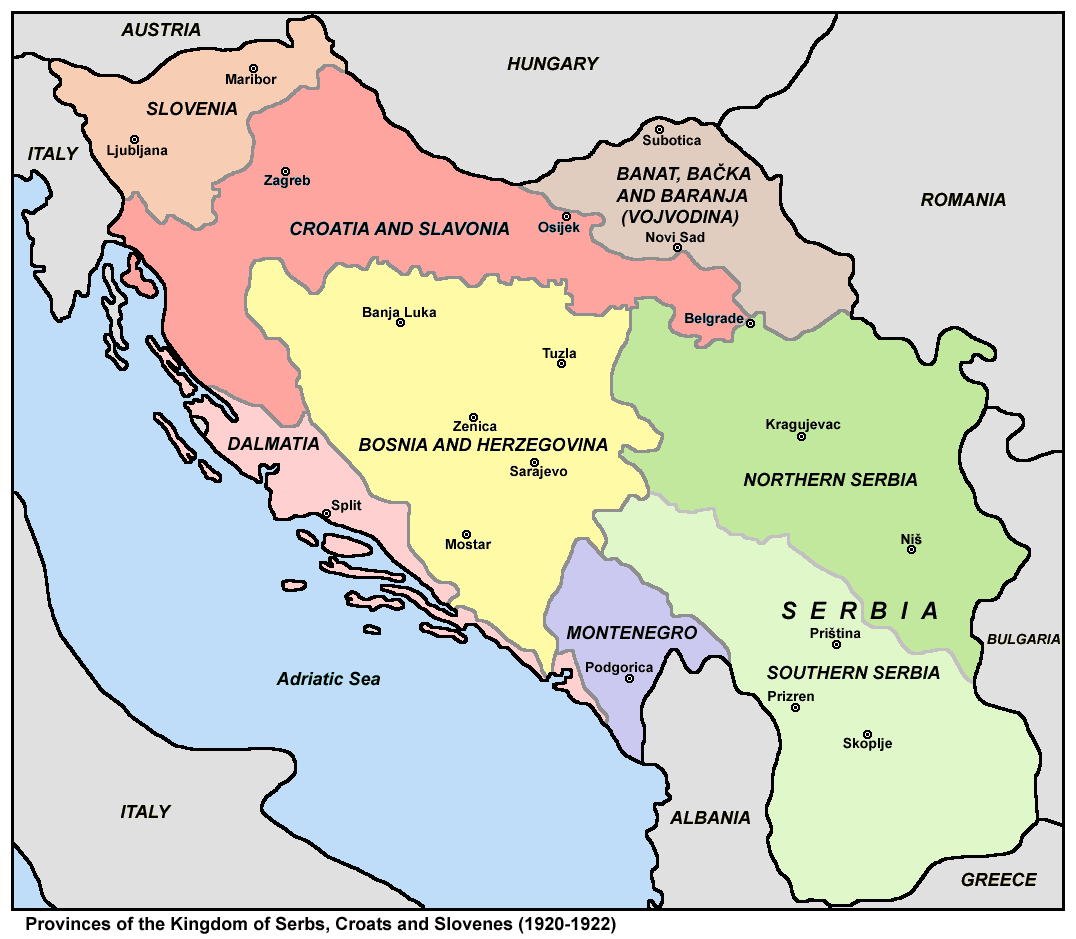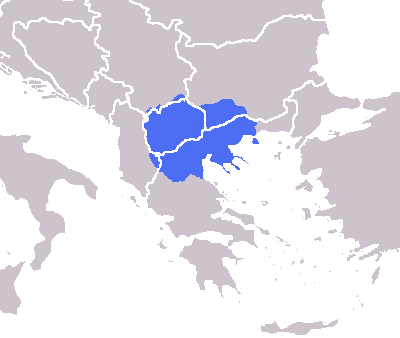|
South Serbia (1919–1922)
South Serbia ( sr, Јужна Србија / ''Južna Srbija'') was a province (''pokrajina'') of the Kingdom of Serbs, Croats and Slovenes that existed between 1919 and 1922. It encompassed the modern territories of Sandžak (parts of Serbia and Montenegro), Kosovo and North Macedonia. The term "Old Serbia", was historically used in Serbian politics, literature and science for the territories of the province. The term continued in use for the Vardar Banovina and Zeta Banovina following its disestablishment. History The province was established in 1919, following the creation of Yugoslavia on 1 December 1918. Serbia in the Balkan Wars, Serbia had greatly expanded its borders during the Balkan Wars. The province was disestablished in 1922 and its territories were reorganized into the Vardar Banovina and Zeta Banovina. The term was then colloquially used for those territories. Economy The province of South Serbia, as a mostly highland region, had favorable conditions for developme ... [...More Info...] [...Related Items...] OR: [Wikipedia] [Google] [Baidu] |
Pokrajina
The subdivisions of the Kingdom of Yugoslavia (initially known as the Kingdom of Serbs, Croats, and Slovenes) existed successively in three different forms. From 1918 to 1922, the kingdom maintained the pre-World War I subdivisions of Yugoslavia's predecessor states. In 1922, the state was divided into 33 ''oblasts'' or provinces and, in 1929, a new system of nine banates (in Serbo-Croatian, the word for "banate" is ''banovina'') was implemented. Pre-Yugoslav subdivisions (1918–1922) From 1918 to 1922, Kingdom of Serbs, Croats, and Slovenes continued to be subdivided into the pre-World War I divisions of Austria-Hungary and the formerly independent kingdoms of Serbia and Montenegro. Provinces (''pokrajine'') were: # Slovenia # Croatia and Slavonia # Dalmatia # Bosnia and Herzegovina # Banat, Bačka and Baranja # Serbia ## Northern Serbia ## Southern Serbia # Montenegro These were subdivided into districts and counties: # District of Andrijevica (former Montenegro) # Distric ... [...More Info...] [...Related Items...] OR: [Wikipedia] [Google] [Baidu] |
Vardar Macedonia
Vardar Macedonia ( Macedonian and sr, Вардарска Македонија, ''Vardarska Makedonija'') was the name given to the territory of the Kingdom of Serbia (1912–1918) and Kingdom of Yugoslavia (1918–1941) roughly corresponding to today's North Macedonia. It covers the northwestern part of geographical Macedonia, whose modern borders came to be defined by the mid-19th century. History Vardar Macedonia usually refers to the central part of the region of Macedonia attributed to the Kingdom of Serbia by the Treaty of Bucharest (1913) after the Balkan Wars. The territory is named after the Vardar, the major river that cuts across the region from northwest to southeast, to distinguish it from both Greek Macedonia and the region around the Pirin Mountain in Bulgaria. The region was initially known as ''Serbian Macedonia'' although the use of the name ''Macedonia'' was prohibited later in the Kingdom of Yugoslavia, due to the implemented policy of Serbianisation of the ... [...More Info...] [...Related Items...] OR: [Wikipedia] [Google] [Baidu] |
Kingdom Of Serbia
The Kingdom of Serbia ( sr-cyr, Краљевина Србија, Kraljevina Srbija) was a country located in the Balkans which was created when the ruler of the Principality of Serbia, Milan I, was proclaimed king in 1882. Since 1817, the Principality was ruled by the Obrenović dynasty (replaced by the Karađorđević dynasty for a short time). The Principality, under the suzerainty of the Ottoman Empire, ''de facto'' achieved full independence when the last Ottoman troops left Belgrade in 1867. The Congress of Berlin in 1878 recognized the formal independence of the Principality of Serbia, and in its composition Nišava, Pirot, Toplica and Vranje districts entered the South part of Serbia. In 1882, Serbia was elevated to the status of a kingdom, maintaining a foreign policy friendly to Austria-Hungary. Between 1912 and 1913, Serbia greatly enlarged its territory through engagement in the First and Second Balkan Wars— Sandžak-Raška, Kosovo Vilayet and Vardar Macedonia ... [...More Info...] [...Related Items...] OR: [Wikipedia] [Google] [Baidu] |
States And Territories Disestablished In 1922
State may refer to: Arts, entertainment, and media Literature * ''State Magazine'', a monthly magazine published by the U.S. Department of State * ''The State'' (newspaper), a daily newspaper in Columbia, South Carolina, United States * ''Our State'', a monthly magazine published in North Carolina and formerly called ''The State'' * The State (Larry Niven), a fictional future government in three novels by Larry Niven Music Groups and labels * States Records, an American record label * The State (band), Australian band previously known as the Cutters Albums * ''State'' (album), a 2013 album by Todd Rundgren * ''States'' (album), a 2013 album by the Paper Kites * ''States'', a 1991 album by Klinik * ''The State'' (album), a 1999 album by Nickelback Television * ''The State'' (American TV series), 1993 * ''The State'' (British TV series), 2017 Other * The State (comedy troupe), an American comedy troupe Law and politics * State (polity), a centralized political organizatio ... [...More Info...] [...Related Items...] OR: [Wikipedia] [Google] [Baidu] |
States And Territories Established In 1919
State may refer to: Arts, entertainment, and media Literature * ''State Magazine'', a monthly magazine published by the U.S. Department of State * ''The State'' (newspaper), a daily newspaper in Columbia, South Carolina, United States * ''Our State'', a monthly magazine published in North Carolina and formerly called ''The State'' * The State (Larry Niven), a fictional future government in three novels by Larry Niven Music Groups and labels * States Records, an American record label * The State (band), Australian band previously known as the Cutters Albums * ''State'' (album), a 2013 album by Todd Rundgren * ''States'' (album), a 2013 album by the Paper Kites * ''States'', a 1991 album by Klinik * ''The State'' (album), a 1999 album by Nickelback Television * ''The State'' (American TV series), 1993 * ''The State'' (British TV series), 2017 Other * The State (comedy troupe), an American comedy troupe Law and politics * State (polity), a centralized political organizatio ... [...More Info...] [...Related Items...] OR: [Wikipedia] [Google] [Baidu] |
1922 Disestablishments In Yugoslavia
Nineteen or 19 may refer to: * 19 (number), the natural number following 18 and preceding 20 * one of the years 19 BC, AD 19, 1919, 2019 Films * ''19'' (film), a 2001 Japanese film * ''Nineteen'' (film), a 1987 science fiction film Music * 19 (band), a Japanese pop music duo Albums * ''19'' (Adele album), 2008 * ''19'', a 2003 album by Alsou * ''19'', a 2006 album by Evan Yo * ''19'', a 2018 album by MHD * ''19'', one half of the double album ''63/19'' by Kool A.D. * ''Number Nineteen'', a 1971 album by American jazz pianist Mal Waldron * ''XIX'' (EP), a 2019 EP by 1the9 Songs * "19" (song), a 1985 song by British musician Paul Hardcastle. * "Nineteen", a song by Bad4Good from the 1992 album ''Refugee'' * "Nineteen", a song by Karma to Burn from the 2001 album ''Almost Heathen''. * "Nineteen" (song), a 2007 song by American singer Billy Ray Cyrus. * "Nineteen", a song by Tegan and Sara from the 2007 album '' The Con''. * "XIX" (song), a 2014 song by Slipknot. ... [...More Info...] [...Related Items...] OR: [Wikipedia] [Google] [Baidu] |
1919 Establishments In Yugoslavia
Events January * January 1 ** The Czechoslovak Legions occupy much of the self-proclaimed "free city" of Bratislava, Pressburg (now Bratislava), enforcing its incorporation into the new republic of Czechoslovakia. ** HMY Iolaire, HMY ''Iolaire'' sinks off the coast of the Hebrides; 201 people, mostly servicemen returning home to Lewis and Harris, are killed. * January 2–January 22, 22 – Russian Civil War: The Red Army's Caspian-Caucasian Front begins the Northern Caucasus Operation (1918–1919), Northern Caucasus Operation against the White Army, but fails to make progress. * January 3 – The Faisal–Weizmann Agreement is signed by Faisal I of Iraq, Emir Faisal (representing the Arab Kingdom of Hejaz) and Zionism, Zionist leader Chaim Weizmann, for Arab–Jewish cooperation in the development of a Jewish homeland in Palestine (region), Palestine, and an Arab nation in a large part of the Middle East. * January 5 – In Germany: ** Spartacist uprising in B ... [...More Info...] [...Related Items...] OR: [Wikipedia] [Google] [Baidu] |
Yugoslav Macedonia
The Socialist Republic of Macedonia ( mk, Социјалистичка Република Македонија, Socijalistička Republika Makedonija), or SR Macedonia, commonly referred to as Socialist Macedonia or Yugoslav Macedonia, was one of the six constituent republics of the post-World War II Socialist Federal Republic of Yugoslavia, and a nation state of the Macedonians. After the transition of the political system to parliamentary democracy in 1990, the Republic changed its official name to Republic of Macedonia in 1991,''On This Day'' – Macedonian Information Agency – MIA , see: 1991 and with the beginning of the |
Yugoslav Serbia
, life_span = 1944–1992 , status = Constituent state of Yugoslavia , p1 = Territory of the Military Commander in Serbia , flag_p1 = Flag of German Reich (1935–1945).svg , p2 = Kingdom of Hungary (1920–1946)Kingdom of Hungary , flag_p2 = Flag of Hungary (1920–1946).svg , p3 = Independent State of Croatia , flag_p3 = Flag of Independent State of Croatia.svg , p4 = Kingdom of Bulgaria , flag_p4 = Flag of Bulgaria.svg , s1 = Republic of Serbia (1992–2006)Republic of Serbia , flag_s1 = Flag of Serbia (1992-2004).svg , image_flag = Flag of the Socialist Republic of Serbia.svg , flag_type = Flag(1947–1992) , image_coat = Coat of arms of Serbia (1947–2004).svg , symbol_type = Emblem(1947–1992) , common_languag ... [...More Info...] [...Related Items...] OR: [Wikipedia] [Google] [Baidu] |
Former Subdivisions Of Serbia
A former is an object, such as a template, gauge or cutting die, which is used to form something such as a boat's hull. Typically, a former gives shape to a structure that may have complex curvature. A former may become an integral part of the finished structure, as in an aircraft fuselage, or it may be removable, being using in the construction process and then discarded or re-used. Aircraft formers Formers are used in the construction of aircraft fuselage, of which a typical fuselage has a series from the nose to the empennage, typically perpendicular to the longitudinal axis of the aircraft. The primary purpose of formers is to establish the shape of the fuselage and reduce the column length of stringers to prevent instability. Formers are typically attached to longerons, which support the skin of the aircraft. The "former-and-longeron" technique (also called stations and stringers) was adopted from boat construction, and was typical of light aircraft built until the ad ... [...More Info...] [...Related Items...] OR: [Wikipedia] [Google] [Baidu] |
Serbianisation
Serbianisation or Serbianization, also known as Serbification, and Serbisation or Serbization ( sh-Latn-Cyrl, separator=" / ", srbizacija, србизација or sh-Latn-Cyrl, label=none, separator=" / ", posrbljavanje, посрбљавање; sq, serbizimi; bg, сърбизация, translit=sarbizatsiya or ; mk, србизација, translit=srbizacija; ro, serbificare) is the spread of Serbian culture, people, and language, either by social integration or by cultural or forced assimilation. Medieval period Populated by Bulgarians and Romanians, the area between the Morava and Timok rivers became part of the Serbian state in 1291/1292 which began the Serbianisation of the region. "An important Romanian concentration existed in the region between the Timok and Morava Rivers.... This region was taken by Serbia in 1291 or 1292 from two Cuman chiefs, Darman and Kudelin, that were first under Hungarian vassalage. Only then did the Serbianization of this region previously pe ... [...More Info...] [...Related Items...] OR: [Wikipedia] [Google] [Baidu] |




